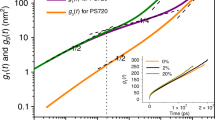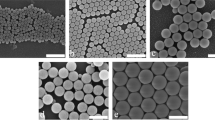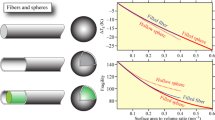Abstract
Owing to the improvement of properties including conductivity, toughness and permeability, polymer nanocomposites are slated for applications ranging from membranes to fuel cells1,2. The enhancement of polymer properties by the addition of inorganic nanoparticles is a complex function of interfacial interactions, interfacial area and the distribution of inter-nanofiller distances. The latter two factors depend on nanofiller dispersion, making it difficult to develop a fundamental understanding of their effects on nanocomposite properties. Here, we design model poly(methyl methacrylate)–silica and poly(2-vinyl pyridine)–silica nanocomposites consisting of polymer films confined between silica slides. We compare the dependence of the glass-transition temperature (Tg) and physical ageing on the interlayer distance in model nanocomposites with the dependence of silica nanoparticle content in real nanocomposites. We show that model nanocomposites provide a simple way to gain insight into the effect of interparticle spacing on Tg and to predict the approximate ageing response of real nanocomposites.
This is a preview of subscription content, access via your institution
Access options
Subscribe to this journal
Receive 12 print issues and online access
$259.00 per year
only $21.58 per issue
Buy this article
- Purchase on Springer Link
- Instant access to full article PDF
Prices may be subject to local taxes which are calculated during checkout




Similar content being viewed by others
References
Vaia, R. A. & Giannelis, E. P. Polymer nanocomposites: Status and opportunities. Mater. Res. Soc. Bull. 26, 394–401 (2001).
Sanchez, C., Julian, B., Belleville, P. & Popall, M. Applications of hybrid organic-inorganic nanocomposites. J. Mater. Chem. 15, 3559–3592 (2005).
Keddie, J. L., Jones, R. A. L. & Cory, R. A. Size-dependent depression of the glass transition temperature in polymer films. Europhys. Lett. 27, 59–64 (1994).
van Zanten, J. H., Wallace, W. E. & Wu, W. L. Effect of strongly favorable substrate interactions on the thermal properties of ultrathin polymer films. Phys. Rev. E 53, R2053–R2056 (1996).
Forrest, J. A., Dalnoki-Veress, K., Stevens, J. R. & Dutcher, J. R. Effect of free surfaces on the glass transition temperature of thin polymer films. Phys. Rev. Lett. 77, 2002–2005 (1996).
Fryer, D. S. et al. Dependence of the glass transition temperature of polymer films on interfacial energy and thickness. Macromolecules 34, 5627–5634 (2001).
Grohens, Y., Hamon, L., Reiter, G., Soldera, A. & Holl, Y. Some relevant parameters affecting the glass transition of supported ultra-thin polymer films. Eur. Phys. J. E 8, 217–224 (2002).
Park, C. H. et al. Thickness and composition dependence of the glass transition temperature in thin random copolymer films. Polymer 45, 4507–4513 (2004).
Ellison, C. J., Kim, S. D., Hall, D. B. & Torkelson, J. M. Confinement and processing effects on glass transition temperature and physical aging in ultrathin polymer films: Novel fluorescence measurements. Eur. Phys. J. E 8, 155–166 (2002).
Ellison, C. J. & Torkelson, J. M. The distribution of glass-transition temperatures in nanoscopically confined glass formers. Nature Mater. 2, 695–700 (2003).
Ellison, C. J., Mundra, M. K. & Torkelson, J. M. Impacts of polystyrene molecular weight and modification to the repeat unit structure on the glass transition-nanoconfinement effect and the cooperativity length scale. Macromolecules 38, 1767–1778 (2005).
Mundra, M. K., Ellison, C. J., Behling, R. E. & Torkelson, J. M. Confinement, composition, and spin-coating effects on the glass transition and stress relaxation of thin films of polystyrene and styrene-containing random copolymers: sensing by intrinsic fluorescence. Polymer 47, 7747–7759 (2006).
Sharp, J. S. & Forrest, J. A. Free surfaces cause reductions in the glass transition temperature of thin polystyrene films. Phys. Rev. Lett. 91, 235701 (2003).
Roth, C. B. & Dutcher, J. R. Glass transition and chain mobility in thin polymer films. J. Electroanal. Chem. 584, 13–22 (2005).
Alcoutlabi, M. & McKenna, G. B. Effects of confinement on material behaviour at the nanometer size scale. J. Phys. Condens. Matter 17, R461–R524 (2005).
Ash, B. J., Schadler, L. S. & Siegel, R. W. Glass transition behavior of alumina/polymethylmethacrylate nanocomposites. Mater. Lett. 55, 83–87 (2002).
Arrighi, V., McEwen, I. J., Qian, H. & Serrano Prieto, M. B. The glass transition and interfacial layer in styrene-butadiene rubber containing silica nanofiller. Polymer 44, 6259–6266 (2003).
Sun, Y. Y., Zhang, Z. Q., Moon, K. S. & Wong, C. P. Glass transition and relaxation behavior of epoxy nanocomposites. J. Polym. Sci. B 42, 3849–3858 (2004).
Berriot, J., Montes, H., Lequeux, F., Long, D. & Sotta, P. Evidence for the shift of the glass transition near the particles in silica-filled elastomers. Macromolecules 35, 9756–9762 (2002).
Blum, F. D., Young, E. N., Smith, G. & Sitton, O. C. Thermal analysis of adsorbed poly(methyl methacrylate) on silica. Langmuir 22, 4741–4744 (2006).
Rittigstein, P. & Torkelson, J. M. Polymer-nanoparticle interfacial interactions in polymer nanocomposites: confinement effects on glass transition temperature and suppression of physical aging. J. Polym. Sci. B 44, 2935–2943 (2006).
Starr, F. W., Schroder, T. B. & Glotzer, S. C. Effects of a nanoscopic filler on the structure and dynamics of simulated polymer melt and the relationship to ultrathin films. Phys. Rev. E 64, 021802 (2001).
Priestley, R. D., Broadbelt, L. J. & Torkelson, J. M. Physical aging of ultrathin polymer films above and below the bulk glass transition temperature: Effects of attractive vs neutral polymer-substrate interactions measured by fluorescence. Macromolecules 38, 654–657 (2005).
Priestley, R. D., Ellison, C. J., Broadbelt, L. J. & Torkelson, J. M. Structural relaxation of polymer glasses at surfaces, interfaces, and in between. Science 309, 456–459 (2005).
Huang, Y. & Paul, D. R. Physical aging of thin glassy polymer films monitored by optical properties. Macromolecules 39, 1554–1559 (2006).
Kawana, S. & Jones, R. A. L. Effect of physical ageing in thin glassy polymer films. Eur. Phys. J. E 10, 223–230 (2003).
Lu, H. B. & Nutt, S. Restricted relaxation in polymer nanocomposites near the glass transition. Macromolecules 36, 4010–4016 (2003).
Bansal, A. et al. Quantitative equivalence between polymer nanocomposites and thin polymer films. Nature Mater. 4, 693–698 (2005).
Papakonstantopoulos, G. J., Yoshimoto, K., Doxastakis, M., Nealey, P. F. & de Pablo, J. J. Local mechanical properties of polymeric nanocomposites. Phys. Rev. E 72, 031801 (2005).
Narayanan, R. A. et al. Dynamics and internal stresses at the nanoscale related to unique thermomechanical behavior in polymer nanocomposites. Phys. Rev. Lett 97, 075505 (2006).
Acknowledgements
This work was supported by the NSF-MRSEC program at Northwestern University (grants DMR-0076097 and DMR-0520513), Northwestern University and a DFI fellowship (R.D.P.).
Author information
Authors and Affiliations
Corresponding author
Ethics declarations
Competing interests
The authors declare no competing financial interests.
Rights and permissions
About this article
Cite this article
Rittigstein, P., Priestley, R., Broadbelt, L. et al. Model polymer nanocomposites provide an understanding of confinement effects in real nanocomposites. Nature Mater 6, 278–282 (2007). https://doi.org/10.1038/nmat1870
Received:
Accepted:
Published:
Issue Date:
DOI: https://doi.org/10.1038/nmat1870
This article is cited by
-
Unraveling bilayer interfacial features and their effects in polar polymer nanocomposites
Nature Communications (2023)
-
Dispersion characteristics of polypropylene/organo-modified single-walled carbon nanotube composites with a long-chain phosphonic acid added as the third dispersant component and their drawn orientation
Polymer Bulletin (2023)
-
Surface control of layered double hydroxides by in-situ initiating & terminating polymerization
Nano Research (2022)
-
Effect of Solid-state Shear Milling Process on Mechanical Properties of PA66/graphene Nanocomposite Fibers
Fibers and Polymers (2021)



